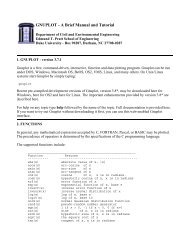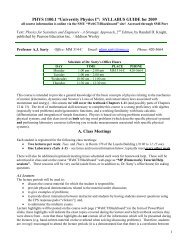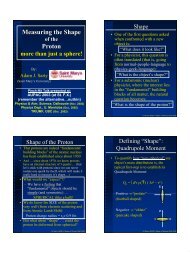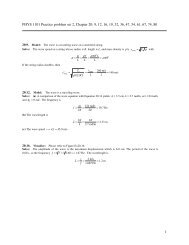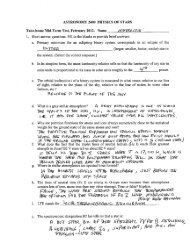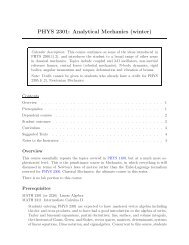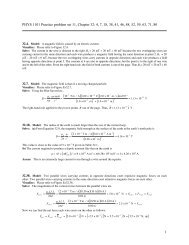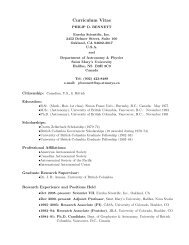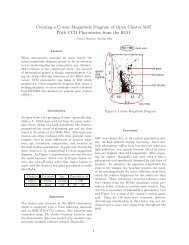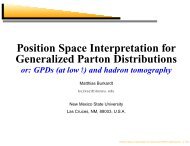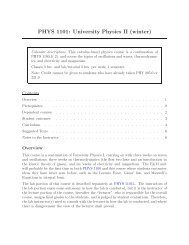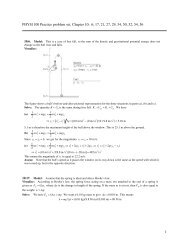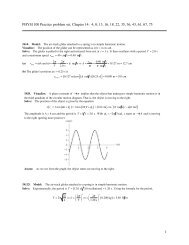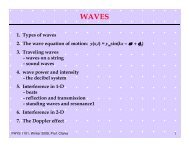Assessing the Yarkovsky Effect in the Kuiper Belt - Astronomy ...
Assessing the Yarkovsky Effect in the Kuiper Belt - Astronomy ...
Assessing the Yarkovsky Effect in the Kuiper Belt - Astronomy ...
You also want an ePaper? Increase the reach of your titles
YUMPU automatically turns print PDFs into web optimized ePapers that Google loves.
<strong>Assess<strong>in</strong>g</strong> <strong>the</strong> <strong>Yarkovsky</strong> <strong>Effect</strong> <strong>in</strong> <strong>the</strong> <strong>Kuiper</strong> <strong>Belt</strong>byDaniel Josef MajaessA THESIS SUBMITTED IN PARTIAL FULFILMENT OFTHEREQUIREMENTSFORTHEDEGREEOFBACHELOR OF SCIENCEwith an honors <strong>in</strong>Astrophysics(Department of <strong>Astronomy</strong> and Physics, Dr. Joseph Hahn Supervis<strong>in</strong>g Faculty)...................................................................................................................................................................................................................................................................................SAINT MARY’S UNIVERSITYMay 3, 2005c○ Daniel Josef Majaess, 2005
Abstract<strong>Assess<strong>in</strong>g</strong> <strong>the</strong> <strong>Yarkovsky</strong> <strong>Effect</strong> <strong>in</strong> <strong>the</strong> <strong>Kuiper</strong> <strong>Belt</strong>, byDaniel Majaess, submittedon May 3, 2005:The <strong>Yarkovsky</strong> <strong>Effect</strong> (YE) is a radiation force that while m<strong>in</strong>ute, has been shownto help deliver asteroids <strong>in</strong>to near earth cross<strong>in</strong>g orbits (NEOs). The force is divided<strong>in</strong>to a seasonal variant due to an object’s yearly revolution and a diurnal componentdue to its daily rotation. We show that <strong>the</strong> seasonal YE causes an orbital decay ofȧ ∼−1AU/Gyr for a small subset of <strong>Kuiper</strong> <strong>Belt</strong> Objects (KBOs) whose diametersrange from 5 − 100m, while <strong>the</strong> diurnal effect is of little consequence <strong>in</strong> <strong>the</strong> <strong>Kuiper</strong><strong>Belt</strong>. Moreover, compared to a controlled run, <strong>the</strong> seasonal YE augments <strong>the</strong> numberof KBOs that diffuse <strong>in</strong>to <strong>the</strong> <strong>in</strong>ner Solar System by a factor of ∼ 100. It was thoughtthat <strong>the</strong> YE could enhance <strong>the</strong> <strong>in</strong>ward transport of KBOs where <strong>the</strong>y may be detectedas Jupiter Family Comets (JFCs), but <strong>the</strong> bodies considered here are 1-2 orders ofmagnitude to small.
ContentsAbstract . . . . . . . . . . . . . . . . . . . . . . . . . . . . . . . . . . . . . . 2Contents . . . . . . . . . . . . . . . . . . . . . . . . . . . . . . . . . . . . . . 3List of Figures . . . . . . . . . . . . . . . . . . . . . . . . . . . . . . . . . . 5List of Tables . . . . . . . . . . . . . . . . . . . . . . . . . . . . . . . . . . . 61 Introduction . . . . . . . . . . . . . . . . . . . . . . . . . . . . . . . . . . 72 The <strong>Yarkovsky</strong> <strong>Effect</strong> . . . . . . . . . . . . . . . . . . . . . . . . . . . . 82.1 An Introduction . . . . . . . . . . . . . . . . . . . . . . . . . . . . . . 82.2 The Seasonal YE . . . . . . . . . . . . . . . . . . . . . . . . . . . . . 92.2.1 Summary . . . . . . . . . . . . . . . . . . . . . . . . . . . . . 162.3 The Diurnal YE . . . . . . . . . . . . . . . . . . . . . . . . . . . . . . 163 Resonances . . . . . . . . . . . . . . . . . . . . . . . . . . . . . . . . . . 184 The N-body Integrator, Mercury6 . . . . . . . . . . . . . . . . . . . . 215 Discussion and Results . . . . . . . . . . . . . . . . . . . . . . . . . . . 235.1 The Delivery Model: YE → Resonance → Ejection. . . . . 235.2 The YE: chang<strong>in</strong>g <strong>the</strong> KB <strong>in</strong>itial & f<strong>in</strong>al states. . . . . . . . . . . . . 24
5.3 The YE: <strong>in</strong>creas<strong>in</strong>g <strong>the</strong> <strong>in</strong>ward flux of KBOs. . . . . . . . . . . . . . . 276 Collisions . . . . . . . . . . . . . . . . . . . . . . . . . . . . . . . . . . . . 297 Conclusions . . . . . . . . . . . . . . . . . . . . . . . . . . . . . . . . . . 31A YE Subrout<strong>in</strong>e for Mercury6 . . . . . . . . . . . . . . . . . . . . . . . 32B IDL Subrout<strong>in</strong>e: Calculat<strong>in</strong>g E(x) and d(x) . . . . . . . . . . . . . 35C Miscellaneous . . . . . . . . . . . . . . . . . . . . . . . . . . . . . . . . . 36Bibliography . . . . . . . . . . . . . . . . . . . . . . . . . . . . . . . . . . . 38Acknowledgements . . . . . . . . . . . . . . . . . . . . . . . . . . . . . . . 40
List of Figures2.1 A depiction of <strong>the</strong> seasonal <strong>Yarkovsky</strong> effect . . . . . . . . . . . . . . 92.2 A contour plot of |ȧ| as a function of x and θ. . . . . . . . . . . . . . 132.3 ȧ for vary<strong>in</strong>g <strong>the</strong>rmal conductivity parameters: K θ=3 =2.2 × 10 4 ergKcms(solid), K ice =5.2 × 10 4ergKcms(dashed). . . . . . . . . . . . . . . . . . 153.1 Ejection of a KBO due to eccentricity pump<strong>in</strong>g . . . . . . . . . . . . 193.2 An anology of Kirkwood Gaps <strong>in</strong> <strong>the</strong> <strong>Kuiper</strong> <strong>Belt</strong> . . . . . . . . . . . 204.1 The fictitious force created to mimic <strong>the</strong> YE . . . . . . . . . . . . . . 225.1 The delivery model <strong>in</strong> action: YE → resonance → ejection . . . . . . 235.2 The population layout for <strong>the</strong> KB at <strong>the</strong> <strong>in</strong>itial and f<strong>in</strong>al states . . . . 255.3 The eccentricity layout for <strong>the</strong> KB at <strong>the</strong> f<strong>in</strong>al state (t =4.5Gyrs).The top graph is <strong>the</strong> simulation evolved with <strong>the</strong> YE, and <strong>the</strong> bottomis <strong>the</strong> control (same simulation without YE). . . . . . . . . . . . . . . 265.4 The <strong>in</strong>ward flux of KBOs over time . . . . . . . . . . . . . . . . . . . 27C.1 Increased eccentircity results <strong>in</strong> a decreased perihelion . . . . . . . . . 36
List of Tables2.1 Def<strong>in</strong>itions for some of <strong>the</strong> chemical and geological variables . . . . . 122.2 Geological parameters used to describe our KBO . . . . . . . . . . . . 14C.1 KB resonances and <strong>the</strong>ir correspond<strong>in</strong>g semi-major axes . . . . . . . 37
Chapter 1IntroductionThe <strong>Kuiper</strong> <strong>Belt</strong> (KB) is a vast swarm of comets that extends beyond Neptune from35 on upwards to 50 AU. These bodies orbit <strong>the</strong> sun and are considered to be abelt much like <strong>the</strong> ma<strong>in</strong> asteroid field between Mars and Jupiter. Unlike <strong>the</strong>ir rockyasteroid counterparts, <strong>the</strong> KB constituents are comets that are made of ices andvolatile material leftover from <strong>the</strong> primordial solar system. In this project, <strong>the</strong> KBis of ma<strong>in</strong> <strong>in</strong>terest because it is generally believed that it is a reservoir for JupiterFamily comets (JFCs) (Levison, 1996). If this is true, an immediate question arisesregard<strong>in</strong>g <strong>the</strong> history of <strong>the</strong>se comets, ma<strong>in</strong>ly what mechanism caused <strong>the</strong>ir <strong>in</strong>wardtransport from <strong>the</strong> KB? Conventional th<strong>in</strong>k<strong>in</strong>g suggests that KBOs get ejected from<strong>the</strong> belt via resonances, however recent HST observations show that <strong>the</strong>re are notenough small KBOs to account for <strong>the</strong> observed abundance of JFCs (Bernste<strong>in</strong> et al.,2004).Recent work on <strong>the</strong> ma<strong>in</strong> asteroid belt has shown that a force entitled <strong>the</strong> <strong>Yarkovsky</strong><strong>Effect</strong> (YE) plays an important role <strong>in</strong> <strong>the</strong> delivery of meteorites and earth cross<strong>in</strong>gobjects (Bottke et al., 2000). The goal of this project is to see whe<strong>the</strong>r this effect—when coupled with resonances—can enhance <strong>the</strong> diffusion of KBOs where <strong>the</strong>y’reobserved as JFCs.
Chapter 2The <strong>Yarkovsky</strong> <strong>Effect</strong>2.1 An IntroductionThe YE is divided <strong>in</strong>to two ma<strong>in</strong> components due to a body’s daily rotation and itsannual revolution around <strong>the</strong> sun. The diurnal YE is <strong>the</strong> daily variant and it arisesfrom <strong>the</strong> temperature differential between <strong>the</strong> surface exposed to <strong>the</strong> sun and <strong>the</strong>darkside. Assum<strong>in</strong>g a blackbody relation, <strong>the</strong> flux of photons from <strong>the</strong> warm side isgreater than that of <strong>the</strong> dark by Ratio =( TwarmT dark) 4 . Hence <strong>the</strong>rmal energy is reradiatedasymmetrically and because photons carry momentum, <strong>the</strong> body will experience athrust which depend<strong>in</strong>g on its rotation may cause an outwards or <strong>in</strong>wards orbitaldrift. Similarly, <strong>the</strong> seasonal component arises from <strong>the</strong> uneven heat<strong>in</strong>g experiencedby a body’s poles, where one may spend half <strong>the</strong> orbital period <strong>in</strong> sunlight and <strong>the</strong>o<strong>the</strong>r <strong>in</strong> <strong>the</strong> dark—creat<strong>in</strong>g a latitud<strong>in</strong>al temperature differential. Contrary to <strong>the</strong>diurnal component, <strong>the</strong> net force due to <strong>the</strong> seasonal effect always causes orbital decay(Figure 2.1).Incidentally <strong>the</strong>se ideas were thought of almost a century ago by Ivan <strong>Yarkovsky</strong>,a civil eng<strong>in</strong>eer who studied various problems <strong>in</strong> his spare time. <strong>Yarkovsky</strong> <strong>the</strong>orizedthat a radiation force, while m<strong>in</strong>ute, could affect <strong>the</strong> dynamical evolution of smallasteroids and particles <strong>in</strong> space. Some forty years after see<strong>in</strong>g Ivan’s <strong>the</strong>ories <strong>in</strong> a
ochure, astronomer Ernst Opik developed <strong>the</strong> first paper on it <strong>in</strong> 1951 (Vokrouhlicky,1998).Figure 2.1: A depiction of <strong>the</strong> seasonal <strong>Yarkovsky</strong> effect: <strong>the</strong> magnitude of <strong>the</strong>force is characterized by <strong>the</strong> size of <strong>the</strong> arrow which is given for several po<strong>in</strong>ts alonga body’s revolution around <strong>the</strong> sun, note that <strong>the</strong> sp<strong>in</strong> axis is ly<strong>in</strong>g <strong>in</strong> <strong>the</strong> orbitalplane. Consider <strong>the</strong> body start<strong>in</strong>g at <strong>the</strong> top of <strong>the</strong> diagram, where <strong>in</strong>cident sunlightstrikes <strong>the</strong> south pole and is absorbed. The body reta<strong>in</strong>s this energy for a time Δtand <strong>the</strong>n reradiates it with a component <strong>in</strong> <strong>the</strong> direction of orbital motion. This actslike a photon rocket and <strong>the</strong> recoil reduces <strong>the</strong> body’s orbital velocity, always caus<strong>in</strong>g<strong>the</strong> orbit to decay, ie. <strong>the</strong> body slowly spirals <strong>in</strong>to <strong>the</strong> sun. Figure from (Rub<strong>in</strong>cam,1998)2.2 The Seasonal YEThe rate at which a body’s semi-major axis (SMA) decays due to <strong>the</strong> seasonal YE isoutl<strong>in</strong>ed <strong>in</strong> (Vokrouhlický, 1999):
ȧ = dadt = 4α 9Φ E(x)s<strong>in</strong>δ(x)s<strong>in</strong> 2 γ (2.1)w rev 1+θ/xwhere α =1− A, is <strong>the</strong> body’s reflectivity s<strong>in</strong>ce A (<strong>the</strong> albedo), is <strong>the</strong> fraction ofsunlight absorbed. The angle between a body’s equator and its orbital plane is <strong>the</strong>obliquity γ, andw rev is <strong>the</strong> body’s mean orbital angular velocity <strong>in</strong> its path around<strong>the</strong> sun:w rev =√GM∗a 3 (2.2)where G is <strong>the</strong> gravitational constant and M ∗ is <strong>the</strong> mass of <strong>the</strong> sun with a be<strong>in</strong>g<strong>the</strong> semi-major axis (ie, <strong>the</strong> body’s average distance from <strong>the</strong> sun). The radiationpressure coefficient Φ is given by:Φ= πR2 F ∗mc(2.3)where m and R are <strong>the</strong> mass and radius respectively. The <strong>in</strong>com<strong>in</strong>g solar radiationor solar flux F ∗ is given by:F ∗ =L ∗4πa 2 (2.4)where L ∗ is <strong>the</strong> amount of energy radiated by <strong>the</strong> sun per second and <strong>the</strong> massof a spherical body is m = ρ × 4 3 πR3 , rho and R are <strong>the</strong> body’s density and radiusrespectively. Eqn(2.3) can now be rewritten as:
Φ= πR2 F ∗mc= πr24π3 ρR3 cL ∗4πa 2 =3L ∗16πρa 2 Rc(2.5)Let’s recast Eqn(2.1) us<strong>in</strong>g:f θ (x) = E(x)s<strong>in</strong>δ(x)1+θ/x(2.6)ȧ = 4α 9Φw revf θ (x)s<strong>in</strong> 2 γ (2.7)We can characterize <strong>the</strong> size of our body by a dimensionless parameter x, andits geological and <strong>the</strong>rmal parameters by θ.The numerator E(x)s<strong>in</strong>δ(x), is a setof complicated functions of x & θ and I refer <strong>the</strong> reader to Vokrouhlický (1999) for<strong>the</strong> details; Appendix (B) provides an IDL subrout<strong>in</strong>e to solve <strong>the</strong>se equations. The<strong>the</strong>rmal parameter θ is a function of <strong>the</strong> body’s <strong>the</strong>rmal conductivity K, <strong>the</strong> specificheat at constant pressure C P , Boltzmann’s constant σ, <strong>the</strong> <strong>the</strong>rmal emissivity ɛ ,and<strong>the</strong> temperature of <strong>the</strong> body T :θ =√ρCp KwɛσT 3 (2.8)When deal<strong>in</strong>g with <strong>the</strong> seasonal YE we set w = w rev , and for <strong>the</strong> diurnal YE weset w = w rot , <strong>the</strong> rotational velocity. The body’s dimensionless size parameter x is
C pKlɛThe heat capacity is <strong>the</strong> amount of energy requiredto <strong>in</strong>crease a material’s temperature by ΔT .The <strong>the</strong>rmal conductivity is <strong>the</strong> rate at which energytravels through a material.The <strong>the</strong>rmal depth is <strong>the</strong> distance an energy waveis able to penetrate through a body’s surface.The <strong>the</strong>rmal emissivity is a measure of a material’sability to absorb and radiate energy.Table 2.1: Def<strong>in</strong>itions for some of <strong>the</strong> chemical and geological parameters used todescribe a ‘body’given <strong>in</strong> terms of <strong>the</strong> <strong>the</strong>rmal depth l and R:x =√2Rl(2.9)where√Kl =ρC p n(2.10)The temperature of <strong>the</strong> sunward-fac<strong>in</strong>g side of a rotat<strong>in</strong>g body is given <strong>in</strong> (Vokrouhlický,1999) as :T 4 =L ∗16πa 2 σ(2.11)F<strong>in</strong>d<strong>in</strong>g θ and x Which Optimize 〈ȧ〉We anticipate that <strong>the</strong> YE will be very weak <strong>in</strong> <strong>the</strong> KB due to <strong>the</strong> great distancefrom <strong>the</strong> sun. Thus for demonstration purposes we only need to consider those bodiesthat suffer <strong>the</strong> maximum orbital decay—this will allow us to determ<strong>in</strong>e if <strong>the</strong> YE isof any consequence <strong>in</strong> <strong>the</strong> KB. We can fur<strong>the</strong>r simplify Eqn(2.7) by <strong>in</strong>troduc<strong>in</strong>g <strong>the</strong>
variable Γ:Γ= 4α 9Φw revs<strong>in</strong> 2 γ (2.12)ȧ = 4α 9Φw revf θ (x)s<strong>in</strong> 2 γ = f θ (x)Γ (2.13)Treat<strong>in</strong>g Γ as a constant, Figure (2.2) shows a contour plot of |a(x, θ)| whichsuggests that bodies with a value of x & θ ≈ 3 have <strong>the</strong> maximum orbital decay(strongest YE).Figure 2.2: A contour plot of |ȧ| as a function of x and θ. Notethat|ȧ| has a localmax at x ≈ 3andθ ≈ 3.
C p The Heat Capacity of Ice 6.1 × 10 6 ergsK·gmρ Density of Ice ρ ≈ 2 gcm 3K The Thermal Conductivity of Ice at T = 250K K=5.2×10 4 ergK·cm·sɛ Thermal Emissivity assum<strong>in</strong>g <strong>the</strong> body is ’dark’ and small ɛ =1−10 rad*n Angular Revolution With a SMA =40AU n=7.9×10s*T Temperature of <strong>the</strong> Body With a SMA =40AU T≈44K=-229 ◦ Ca Semi-major axis a =40AUTable 2.2: Geological parameters used to describe our KBO, variables marked with‘*’ have been calculated us<strong>in</strong>g <strong>the</strong> equations above.F<strong>in</strong>d<strong>in</strong>g <strong>the</strong> Radius, Thermal Depth, and Thermal Conductivity WhichMaximizes <strong>the</strong> Orbital Decay due to <strong>the</strong> YETable (2.2) <strong>in</strong>dicates <strong>the</strong> values of K, C p & ρ used to describe a KBO made of ice(Lide, 1999). Solv<strong>in</strong>g Eqn(2.8) we f<strong>in</strong>d that θ = 5, which is comparable to our optimalvalue of θ = 3 (Figure 2.2). Adapt<strong>in</strong>g x & θ ≈ 3, we can recursively determ<strong>in</strong>e <strong>the</strong>correspond<strong>in</strong>g <strong>the</strong>rmal conductivity, <strong>the</strong>rmal depth, and size. The <strong>the</strong>rmal conductivitythat optimizes <strong>the</strong> YE is K θ=3 =2.2 × 10 4ergKcms, solv<strong>in</strong>g Eqn(2.10) we obta<strong>in</strong> a<strong>the</strong>rmal depth of l θ=3 ≈ 15m. Eqn(2.9) is re-arranged to f<strong>in</strong>d a radius of R θ=3 ≈ 30m.Semi-Major Axis and Eccentricity EvolutionNow that all <strong>the</strong> variables and equations are known we can solve <strong>the</strong> constant Γ <strong>in</strong>Eqn(2.13) and obta<strong>in</strong> a value for <strong>the</strong> optimal decay rate:ȧ = −0.75 AUGyr≈−1AUGyr(2.14)Lastly, due to <strong>the</strong> YE a body’s eccentricity evolves accord<strong>in</strong>g to Eqn(1) <strong>in</strong> (Ru-
Figure 2.3: ȧ for vary<strong>in</strong>g <strong>the</strong>rmal conductivity parameters: K θ=3 =2.2 × 10 4(solid), K ice =5.2 × 10 4 erg (dashed).Kcmsb<strong>in</strong>cam, 1998) :ergKcmse(t) =e 0[ a(t)a 0] 0.72(2.15)where e 0 and a 0 are <strong>the</strong> eccentricity and semi-major axis evaluated at time t = t 0 .We can differentiate Eqn(2.15) to obta<strong>in</strong>:ė = dedt = −0.72eȧ a(2.16)
2.2.1 SummaryFigure (2.3) shows that an optimal SMA decay of ȧ ∼−1.0AU/Gyr occurs for aKBO of radius R ≈ 30m. With <strong>the</strong> present age of our solar system at ≈ 4.5Gyrs,a comet of that size would take 15 Gyrs to arrive <strong>in</strong>to <strong>the</strong> <strong>in</strong>ner solar system from<strong>the</strong> KB. Thus we can conclude that <strong>the</strong> seasonal YE is much to weak on its own tocause <strong>the</strong> diffusion of comets from <strong>the</strong> KB <strong>in</strong>to <strong>the</strong> <strong>in</strong>ner solar system. However, <strong>the</strong>follow<strong>in</strong>g simulations <strong>in</strong> Chapter 5 demonstrate that <strong>the</strong> YE can play a role <strong>in</strong> anoverall delivery system by replenish<strong>in</strong>g local resonances with KBOs.2.3 The Diurnal YEThe rate at which a body’s SMA decays due to <strong>the</strong> diurnal YE is outl<strong>in</strong>ed <strong>in</strong> (Vokrouhlicky,1998), Eqn(35):ȧ = dadt = −8α 9Φw revf θ (x)cosγ (2.17)dadt = −f θ(x) 8α 9Φw revcosγ = f θ (x)Γ 2 (2.18)Notice that <strong>the</strong> equation differs from <strong>the</strong> seasonal YE (Eqn 2.7) by a constant, so<strong>the</strong> diurnal variant is also strongest when x & θ ≈ 3. Us<strong>in</strong>g Table (2.2), let’s calculate<strong>the</strong> <strong>the</strong>rmal parameter due to a body’s rotational motion:θ =√ρCp Kw rotɛσT 3 (2.19)Sheppard and Jewitt (2002) suggest that KBOs of diameter >200km have or-
ital periods of approximately 8 hours, so <strong>the</strong> rotational velocity becomes w rot =2πP rot(8hours)=2× 10−4 radsec. Plugg<strong>in</strong>g this <strong>in</strong>to <strong>the</strong> equation above, θ ≈ 2000 which ismuch bigger than our optimal value of θ = 3. Thus we can conclude that <strong>the</strong> orbitaldrift caused by <strong>the</strong> diurnal YE is too small to be of any consequence <strong>in</strong> <strong>the</strong> KB.
Chapter 3ResonancesA resonance is a site <strong>in</strong> <strong>the</strong> Solar System where <strong>the</strong> orbital periods of two bodies arecommensurate (ratios of <strong>in</strong>tegers). For example, a KBO that is near a 5:2 resonancewill orbit <strong>the</strong> sun twice for every five of Neptune’s. More importantly, KBOs near<strong>the</strong>se resonances will experience periodic perturbations from <strong>the</strong> giant planet whichcan lead to an <strong>in</strong>crease <strong>in</strong> eccentricity and a more elongated orbit. With <strong>in</strong>creas<strong>in</strong>geccentricity <strong>the</strong> body’s perihelia 1 decreases and this can cause <strong>the</strong> KBO’s orbit tocross Neptune’s. 2A close-approach may result <strong>in</strong> <strong>the</strong> particle be<strong>in</strong>g gravitationallyscattered by <strong>the</strong> planet; an example is shown <strong>in</strong> Figure (3.1).Astronomers who study <strong>the</strong> ma<strong>in</strong> belt are fortunate <strong>in</strong> that <strong>the</strong>y can directlyobserve <strong>the</strong> strength of <strong>the</strong> resonance phenomena through Kirkwood Gaps, areas <strong>in</strong><strong>the</strong> ma<strong>in</strong> belt devoid of asteroids due to resonances with Jupiter. However, due tosmall comet sizes and <strong>the</strong>ir distance away from earth, <strong>the</strong> KB rema<strong>in</strong>s just outside <strong>the</strong>limit of acquir<strong>in</strong>g solid observational data. As a result, <strong>the</strong>se ‘telescopic effects’ h<strong>in</strong>derus from know<strong>in</strong>g <strong>the</strong> true KB layout and so we must depend heavily on computersimulations and ma<strong>the</strong>matical extrapolation (Grundy et al., 2002). Figure (3.2) showsa numerically generated KB with 10 4 particles evenly distributed between 35 & 701 The po<strong>in</strong>t <strong>in</strong> <strong>the</strong> orbit nearest to <strong>the</strong> sun.2 Increase <strong>in</strong> eccentricity → decrease <strong>in</strong> perihelia → overlapp<strong>in</strong>g orbits, see Appendix (C), Figure(C.1)
AU—this simulation exhibits gaps devoid of KBOs between (5:4 & 4:3) and (3:2 &5:3) resonances 3 , a direct analogy of Kirkwood Gaps.Figure 3.1: Ejection of a KBO due to eccentricity pump<strong>in</strong>g: a particle starts <strong>in</strong> <strong>the</strong>4:3 resonance where its eccentricity is pumped up by Neptune until it crosses thatplanet’s orbit. A close-approach results <strong>in</strong> gravitational scatter<strong>in</strong>g and <strong>the</strong> particle isthrown about <strong>the</strong> solar system. The horizontal dashed l<strong>in</strong>e <strong>in</strong>dicates <strong>the</strong> eccentricitya particle must have <strong>in</strong> order to cross Neptune’s orbit: e>1 − r p /a where (r p )isNeptune’s perihelion distance.3 For a list of strong KB resonances and <strong>the</strong>ir correspond<strong>in</strong>g semi-major axes see Appendix (C),Table (C).
Chapter 4The N-body Integrator, Mercury6The n-body <strong>in</strong>tegrations <strong>in</strong> this project were performed us<strong>in</strong>g <strong>the</strong> Mercury6 code(Chambers, 1999). The simulations used <strong>the</strong> hybrid symplectic/Bulirsch-Stoer <strong>in</strong>tegratoralong with an additional subrout<strong>in</strong>e used to mimic <strong>the</strong> YE (see Appendix (A)).Mercury6 allows <strong>the</strong> user to add an additional acceleration, f: ⃗⃗f =[0.98 (⃗v − ⃗v c)+ 1 ]an 2 ˆθ 〈ȧ〉 n (4.1)where ⃗v is <strong>the</strong> velocity of a particle, ⃗v cis its velocity <strong>in</strong> a circular orbit, <strong>the</strong>acceleration of <strong>the</strong> particle is <strong>in</strong> <strong>the</strong> polar direction ˆθ, and recall that <strong>the</strong> rate of <strong>the</strong>orbital decay due to <strong>the</strong> seasonal YE is given by 〈ȧ〉 ∼−1AU/Gyr. By <strong>in</strong>sert<strong>in</strong>g thisacceleration f ⃗ <strong>in</strong>to Gauss’ eqns (Murray and Dermott, 1999), one can show that <strong>the</strong>particle’s semi-major axis a(t) and eccentricity e(t) will decay at <strong>the</strong> desired rates,Eqns (2.14) and (2.16). Moreover, Figure 4.1 supports that this is <strong>in</strong>deed <strong>the</strong> case.Hav<strong>in</strong>g <strong>the</strong> code equipped with <strong>the</strong> YE, we can go ahead with our simulations <strong>in</strong>which <strong>the</strong> follow<strong>in</strong>g is assumed:• 10 4 particles will be evenly distributed between 35-75AU and evolved for 4.5Gyrs—<strong>the</strong> current age of our solar system.• The YE shall cause a constant SMA decay of ȧ ∼−1AU/Gyr for all particles
Figure 4.1: Us<strong>in</strong>g <strong>the</strong> fictitious force created to mimic <strong>the</strong> YE Eqn(4.1), a particle’sorbit decays at <strong>the</strong> desired rates a(t) Eqn(2.14), and e(t) Eqn(2.16). The jagged l<strong>in</strong>esare a result of perturbations on <strong>the</strong> body due to <strong>the</strong> force of gravity with <strong>the</strong> Sun and<strong>the</strong> four giant planets.but <strong>the</strong>y shall have vary<strong>in</strong>g ė accord<strong>in</strong>g to Eqn(2.16), which implies a size ofR ∼ 30m• These particles are massless which is justified s<strong>in</strong>ce we are deal<strong>in</strong>g with smallsized bodies. The gravitational force felt by a given particle is due to <strong>the</strong> sunand <strong>the</strong> four giant planets: Jupiter, Saturn, Uranus, and Neptune.• Solar system formation models require KBOs to be be dynamically cold—mean<strong>in</strong>g <strong>the</strong> particles shall start with very low eccentricities ē =1.0 × 10 −3 .• Collisions among <strong>the</strong> particles were ignored, see <strong>the</strong> discussion <strong>in</strong> Chapter 6.
Chapter 5Discussion and Results5.1 The Delivery Model: YE → Resonance → Ejection.Follow<strong>in</strong>g <strong>the</strong> role played by <strong>the</strong> YE <strong>in</strong> <strong>the</strong> asteroid belt, we will consider whe<strong>the</strong>r<strong>the</strong> force can deliver KBOs <strong>in</strong>to nearby resonances where eccentricity pump<strong>in</strong>g maycause a close-approach with Neptune and result <strong>in</strong> a KBO be<strong>in</strong>g scattered (Figure5.1).Figure 5.1: The delivery model <strong>in</strong> action: <strong>the</strong> top graph shows a particle start<strong>in</strong>gat ≈46AU be<strong>in</strong>g transported to <strong>the</strong> 5:3 resonance by <strong>the</strong> YE. Eccentricity pump<strong>in</strong>gleads it to exceed <strong>the</strong> threshold required for scatter<strong>in</strong>g by Neptune and it is thrownabout <strong>the</strong> solar system. Similarly, <strong>the</strong> bottom graph depicts a particle start<strong>in</strong>g at≈44AU and be<strong>in</strong>g dragged by <strong>the</strong> YE <strong>in</strong>to <strong>the</strong> 5:3 resonance where it shares <strong>the</strong> samefate as <strong>the</strong> particle above.
5.2 The YE: chang<strong>in</strong>g <strong>the</strong> KB <strong>in</strong>itial & f<strong>in</strong>alstates.Exam<strong>in</strong><strong>in</strong>g <strong>the</strong> consequence of <strong>the</strong> YE on <strong>the</strong> KB is accomplished by compar<strong>in</strong>g <strong>the</strong>KB layout at t =4.5Gyrs to a control, which is <strong>the</strong> same simulation except with <strong>the</strong>YE turned off. Accord<strong>in</strong>g to Figure (5.2) & (5.3), <strong>the</strong> YE has completely eroded <strong>the</strong>KB of <strong>the</strong>se small R ∼ 30m bodies between <strong>the</strong> 5:4 & 5:3 resonances and <strong>the</strong>n aga<strong>in</strong>between <strong>the</strong> 5:3 & 3:2—a distance of ∼ 7AU for <strong>the</strong> former! The YE has helped<strong>the</strong> 2:1 resonance trap over 1200 particles (Figure 5.2), almost four times <strong>the</strong> amountwithout <strong>the</strong> YE. Resonance trapp<strong>in</strong>g occurs when <strong>the</strong> energy and angular momentumtransferred to <strong>the</strong> particle from <strong>the</strong> giant planet are balanced by that which <strong>the</strong> YEhas imposed, effectively <strong>in</strong>itiat<strong>in</strong>g an equilibrium so <strong>the</strong> particle rema<strong>in</strong>s ‘trapped’ <strong>in</strong>that resonance. Accord<strong>in</strong>g to Figure (5.3), particles <strong>in</strong> every major resonance havehad <strong>the</strong>ir eccentricites pumped, <strong>the</strong> YE facilitates this process by dragg<strong>in</strong>g particleseven closer to <strong>the</strong> resonance’s center. Moreover, significant pump<strong>in</strong>g has occurred at<strong>the</strong> 5:3 & 7:4 resonances and particles that passed through <strong>the</strong> 2:1 and <strong>the</strong> weak 3:1resonance have had <strong>the</strong>ir orbits perturbed.
Figure 5.2: Population statistics for <strong>the</strong> KB at <strong>the</strong> <strong>in</strong>itial and f<strong>in</strong>al states: <strong>the</strong>dashed l<strong>in</strong>e <strong>in</strong>dicates t = 0, and <strong>the</strong> solid t =4.5Gyrs. The top graph is <strong>the</strong> simulationevolved with <strong>the</strong> YE, and <strong>the</strong> bottom is <strong>the</strong> control (same simulation without YE).
Figure 5.3: The eccentricity layout for <strong>the</strong> KB at <strong>the</strong> f<strong>in</strong>al state (t =4.5Gyrs).The top graph is <strong>the</strong> simulation evolved with <strong>the</strong> YE, and <strong>the</strong> bottom is <strong>the</strong> control(same simulation without YE).
5.3 The YE: <strong>in</strong>creas<strong>in</strong>g <strong>the</strong> <strong>in</strong>ward flux of KBOs.Figure (5.2) demonstrates that <strong>the</strong> KB’s <strong>in</strong>ner edge is almost completely depletedof <strong>the</strong>se small bodies. We exam<strong>in</strong>e <strong>the</strong> possibility that <strong>the</strong>se miss<strong>in</strong>g particles wereejected <strong>in</strong>to planet-cross<strong>in</strong>g orbits with<strong>in</strong> <strong>the</strong> <strong>in</strong>ner solar system.Figure 5.4: The <strong>in</strong>ward flux of KBOs over time: at <strong>the</strong> f<strong>in</strong>al iteration of t =4.5Gyrs<strong>the</strong> YE contributes to an <strong>in</strong>crease of ∼ 100 times <strong>the</strong> <strong>in</strong>com<strong>in</strong>g KBOs.Figure (5.4) is a plot of <strong>the</strong> number of simulated particles hav<strong>in</strong>g a semi-majoraxis less than Neptune’s at time t =4.5Gyrs. Aga<strong>in</strong>, <strong>the</strong> solid l<strong>in</strong>e represents <strong>the</strong>simulation hav<strong>in</strong>g <strong>the</strong> YE turned on and <strong>the</strong> dashed l<strong>in</strong>e is <strong>the</strong> control with YE off.Initially both runs have an equal amount of <strong>in</strong>com<strong>in</strong>g bodies due to <strong>the</strong> fact that<strong>the</strong>y have <strong>the</strong> same <strong>in</strong>itial KBO distribution.Hence, particles start<strong>in</strong>g near or <strong>in</strong>resonances may get ejected <strong>in</strong> both.However, without <strong>the</strong> YE <strong>the</strong> flux decreases
at later times because <strong>the</strong>re is no mechanism to deliver particles from <strong>the</strong>ir start<strong>in</strong>gposition <strong>in</strong>to a strong resonance. Essentially, <strong>the</strong> YE gives particles who don’t start <strong>in</strong>or near a resonance <strong>the</strong> possibility of gett<strong>in</strong>g <strong>the</strong>re due to <strong>the</strong> imposed semi-major axisdecay rate of ȧ ∼−1AU/Gyr. Thus <strong>the</strong> effect will cont<strong>in</strong>ually replenish resonanceswith KBOs and allow <strong>the</strong>m <strong>the</strong> opportunity to be ejected. As a result, it appearsthat <strong>the</strong> <strong>Yarkovsky</strong> enabled run ejects ∼ 100 times <strong>the</strong> number of KBOs <strong>in</strong>to <strong>the</strong>solar system at <strong>the</strong> f<strong>in</strong>al iteration (t =4.5Gyrs).
Chapter 6CollisionsIf <strong>the</strong> collision timescale <strong>in</strong> <strong>the</strong> KB is much less than that of <strong>the</strong> YE (T YE ≈ 10 9 yrs),KBOs would cont<strong>in</strong>ue to fragment until <strong>the</strong>y are significantly smaller than <strong>the</strong> optimalradius of 30m—thus mak<strong>in</strong>g <strong>the</strong> YE negligible. Let’s go ahead and obta<strong>in</strong> a roughapproximation for <strong>the</strong> collision timescale.Us<strong>in</strong>g an estimate for <strong>the</strong> mass of <strong>the</strong> KB, M KB =0.02M ⊕ (Hahn and Malhotra,2005), we can derive <strong>the</strong> total number of KBOs assum<strong>in</strong>g that <strong>the</strong>y’re all of equalsize and composition:N = M kbm kbo=M kb4π3 ρR3 kbo(6.1)where m kbo is <strong>the</strong> mass of a s<strong>in</strong>gle KBO and R kbo is its radius. Assum<strong>in</strong>g <strong>the</strong> KBis a disk with an outer radius of 50AU and an <strong>in</strong>ner of 30, <strong>the</strong> surface area is givenby:A kb = π(Rout 2 − R<strong>in</strong>) 2 =10 30 cm 2 (6.2)depth:The fraction of <strong>the</strong> belt that is occupied by KBOs can be described by <strong>the</strong> opticalτ = N × A kboA kb= 3M kb4ρR kbo A kb(6.3)where A kbo = πRkbo 2 , is just <strong>the</strong> cross-sectional area of a KBO. F<strong>in</strong>ally, <strong>the</strong> collision
timescale is related to orbital period P orb and <strong>the</strong> optical depth τ:T c = P orbτ(6.4)where <strong>the</strong> orbital period is simply2πw rev=250 yrs, and recall w rev is given byEqn(2.2).S<strong>in</strong>ce a KBO is <strong>in</strong> an <strong>in</strong>cl<strong>in</strong>ed orbit, it penetrates <strong>the</strong> KB plane twiceper period, so <strong>the</strong> probability of a collision per orbit is P c =2τ/P orb . The collisiontimescale is thus:T c = P −1c= P orb2τ= 2P orbρR kbo A kb3M kb(6.5)Of course our results will depend upon <strong>the</strong> details of <strong>the</strong> KBO size distributionwhich our simple calculation neglects.If we assume <strong>the</strong> KB’s optical depth τ isdom<strong>in</strong>ated by 1 km sized bodies R kbo ∼ 1km, <strong>the</strong>nT c =10 11 yrs. Thissuggests thatcollisions can be neglected s<strong>in</strong>ce our collision timescale is even much larger than <strong>the</strong>age of <strong>the</strong> solar system.
Chapter 7ConclusionsWe have shown that <strong>the</strong> orbital drift due to <strong>the</strong> diurnal YE is too small to be ofany consequence <strong>in</strong> <strong>the</strong> KB. However, <strong>the</strong> seasonal variant causes a maximum orbitdecay of ȧ ∼−1AU/Gyr for a small subset of KBOs whose physical properties mustconspire such that <strong>the</strong>ir <strong>the</strong>rmal and size parameters, θ and x, are both near 3.These comets correspond to hav<strong>in</strong>g a diameter of ∼60m and a <strong>the</strong>rmal conductivityof K θ=3 =2.2 × 10 4ergKcms, which is approximately half that of ice water.By cont<strong>in</strong>ually replenish<strong>in</strong>g resonances with KBOs, <strong>the</strong> seasonal YE significantlyenhances <strong>the</strong>ir transport <strong>in</strong>to <strong>the</strong> <strong>in</strong>ner solar system. Unfortunately, <strong>the</strong>se <strong>Yarkovsky</strong>drivenKBOs are 1-2 orders of magnitude too small to be considered <strong>the</strong> progenitorsof <strong>the</strong> JFCs.
Appendix AYE Subrout<strong>in</strong>e for Mercury6c%%%%%%%%%%%%%%%%%%%%%%%%%%%%%%%%%%%%%%%%%%%%%%%%%%%%cc MFO_USER.FOR (ErikSoft 2 March 2001)c (YE Subrout<strong>in</strong>e Added Summer 2004)cc%%%%%%%%%%%%%%%%%%%%%%%%%%%%%%%%%%%%%%%%%%%%%%%%%%%%cc Author: John E. Chambersc Author: Daniel Majaessc Physics Derived By: Prof. Josef Hahnc Applies <strong>the</strong> YE.cc If us<strong>in</strong>g with <strong>the</strong> symplectic algorithm MAL_MVS, <strong>the</strong> force should bec small compared with <strong>the</strong> force from <strong>the</strong> central object.c If us<strong>in</strong>g with <strong>the</strong> conservative Bulirsch-Stoer algorithm MAL_BS2, <strong>the</strong>c force should not be a function of <strong>the</strong> velocities.cc N.B. All coord<strong>in</strong>ates and velocities must be with respect to centralc bodyc ===c----------csubrout<strong>in</strong>e mfo_user (time,nbod,nbig,m,x,v,a,params)cimplicit none<strong>in</strong>clude ’mercury.<strong>in</strong>c’cc Input/Output<strong>in</strong>teger nbod, nbigreal*8 time,jcen(3),m(nbod),x(3,nbod),v(3,nbod),a(3,nbod)real*8 params(3,nbod)cc Local<strong>in</strong>teger j,k
eal*8 tau,da,sigma,t_factor,r,v2,one_over_a,factor,dadtreal*8 r_1,a_s,v_2,n,a_dot,b1,b2,b3cc--------cdo j = 2, nbodc zero <strong>the</strong> accelerationsa(1,j) = 0.d0a(2,j) = 0.d0a(3,j) = 0.d0c migration parameterstau=params(1,j)da=params(2,j)sigma=params(3,j)c Compute <strong>the</strong> planet’s accelerations.if (tau .gt. 0.d0) <strong>the</strong>nt_factor=0.5d0*exp(-time/tau)/taur=x(1,j)**2+x(2,j)**2+x(3,j)**2r=sqrt(r)v2=v(1,j)**2+v(2,j)**2+v(3,j)**2one_over_a=2.d0/r-v2/K2factor=t_factor*da*one_over_aa(1,j)=factor*v(1,j)a(2,j)=factor*v(2,j)a(3,j)=factor*v(3,j)end ifa_dot=params(3,j)if (abs(a_dot) .gt. 0.d0) <strong>the</strong>nccccDeclare EquationsVelocity Vectorv_2=(v(1,j)**2+v(2,j)**2+v(3,j)**2)Radius Vectorr_1=sqrt(x(1,j)**2+x(2,j)**2+x(3,j)**2)SMAa_s=1.d0/(2.d0/r_1-v_2/K2)
cN, mean motionn=sqrt(K2/abs(a_s)**3)c Calculate some terms for efficiencyb1=0.98*a_dot/a_sb2=0.5*a_dot*n/r_1b3=a_s*n/r_1c&&The acceleration Componentsa(1,j)=b1*(v(1,j)+x(2,j)*b3)-x(2,j)*b2a(2,j)=b1*(v(2,j)-x(1,j)*b3)+x(1,j)*b2a(3,j)=0.0d0end ifend doccc-----------creturnendcc%%%%%%%%%%%%%%%%%%%%%%%%%%%%%%%%%%%%%%%%
Appendix BIDL Subrout<strong>in</strong>e: Calculat<strong>in</strong>g E(x)and d(x);Created by Prof. Josef Hahn.;calculate <strong>the</strong> E and delta functions used <strong>in</strong> <strong>the</strong> formula for <strong>the</strong> YE;described <strong>in</strong> Vokrouhlicky (1999), A&A, v344, p362. The <strong>in</strong>puts are <strong>the</strong>;dimensionless radius x (which can be an array) and <strong>the</strong>ta (a number),;while <strong>the</strong> outputs are E(x) and delta(x)pro Ed,x,<strong>the</strong>ta,E,deltachi=<strong>the</strong>ta/xfactor=chi/(1.0+chi);A,B,C,D functionsA=-(x+2.0)-exp(x)*( (x-2.0)*cos(x) - x*s<strong>in</strong>(x) )B=-x-exp(x)*( x*cos(x) + (x-2.0)*s<strong>in</strong>(x) )C=A+factor*(3.0*(x+2.0)+exp(x)*(3.0*(x-2.0)*cos(x) + x*(x-3.0)*s<strong>in</strong>(x)))D=B+factor*(x*(x+3.0)-exp(x)*(x*(x-3.0)*cos(x) - 3.0*(x-2.0)*s<strong>in</strong>(x)));E*exp(i*delta)num=dcomplex(A,B)den=dcomplex(C,D)Ed=num/denEd_real=real_part(Ed)Ed_imag=imag<strong>in</strong>ary(Ed);E and deltaE=sqrt(Ed_real^2+Ed_imag^2)delta=atan(Ed_imag,Ed_real)returnend
Appendix CMiscellaneousFigure C.1: Consider <strong>the</strong> orbits of two bodies with different semi-major axes (SMA)and masses, <strong>the</strong> larger’s orbit <strong>in</strong> solid and <strong>the</strong> crosshair <strong>in</strong>dicates <strong>the</strong> location of <strong>the</strong>sun. With <strong>in</strong>creas<strong>in</strong>g eccentricity, <strong>the</strong> smaller body’s perihelion decreases and so itapproaches <strong>the</strong> sun and <strong>the</strong> o<strong>the</strong>r body. With a high enough eccentricity a closeencounter will most likely result <strong>in</strong> <strong>the</strong> smaller body be<strong>in</strong>g scattered.
Resonance Semi-major axis (AU)5:4 34.94:3 36.53:2 39.55:3 42.37:4 43.72:1 47.83:1 62.6Table C.1: KB resonances and <strong>the</strong>ir correspond<strong>in</strong>g semi-major axes
BibliographyG. M. Bernste<strong>in</strong>, D. E. Trill<strong>in</strong>g, R. L. Allen, M. E. Brown, M. Holman, and R. Malhotra.The Size Distribution of Trans-Neptunian Bodies. The Astronomical Journal,128:1364–1390, September 2004.W. F. Bottke, D. P. Rub<strong>in</strong>cam, and J. A. Burns. Dynamical evolution of ma<strong>in</strong>belt meteoroids: Numerical simulations <strong>in</strong>corporat<strong>in</strong>g planetary perturbations and<strong>Yarkovsky</strong> <strong>the</strong>rmal forces. Icarus, 145:301–331, June 2000.J. E. Chambers. A hybrid symplectic <strong>in</strong>tegrator that permits close encounters betweenmassive bodies. Monthly Notices of <strong>the</strong> Royal Astronomical Society, 304:793–799, April 1999.W. M. Grundy, H. F. Levison, J. W. Parker, R. L. Allen, L. C. Ball, J. F. Cooper,M. C. de Sanctis, T. L. Farnham, B. Gladman, J. M. Hahn, C. W. Hergenro<strong>the</strong>r,J. J. Kavelaars, H. Krueger, D. J. Lien, R. Malhotra, R. M. E. Mastrapa, A. Quillen,R. Srama, J. A. Stansberry, G. Strazzulla, R. J. Terrile, and C. A. Trujillo. Prob<strong>in</strong>gThe Solar System’s Outermost Frontier: The Future of <strong>Kuiper</strong> <strong>Belt</strong> Studies. InAstronomical Society of <strong>the</strong> Pacific Conference Series, pages 337–354, August 2002.J. M. Hahn and R. Malhotra. A Detailed Comparison of Simulations of Neptune’sMigration to Observations of <strong>the</strong> <strong>Kuiper</strong> <strong>Belt</strong>. submitted to <strong>the</strong> Astronomical Journal,2005.H. F. Levison. Comet Taxonomy. In Astronomical Society of <strong>the</strong> Pacific ConferenceSeries, pages 173–191, 1996.D. R. Lide, editor. The CRC Handbook of Chemistry and Physics. 80th edition,1999.C. D. Murray and S. F. Dermott. Solar system dynamics. Solar system dynamicsby Murray, C. D., 1999, 1999.D. P. Rub<strong>in</strong>cam. <strong>Yarkovsky</strong> <strong>the</strong>rmal drag on small asteroids and Mars-Earth delivery.Journal Of Geophysical Reasearch, 103(12):1725–+, January 1998.S. S. Sheppard and D. C. Jewitt. Time-resolved Photometry of <strong>Kuiper</strong> <strong>Belt</strong> Objects:Rotations, Shapes, and Phase Functions. Astronomical Journal, 124:1757–1775,September 2002.D. Vokrouhlický. A complete l<strong>in</strong>ear model for <strong>the</strong> <strong>Yarkovsky</strong> <strong>the</strong>rmal force on sphericalasteroid fragments. <strong>Astronomy</strong> and Astrophysics, 344:362–366, April 1999.
D. Vokrouhlicky. Diurnal <strong>Yarkovsky</strong> effect as a source of mobility of meter-sizedasteroidal fragments. I. L<strong>in</strong>ear <strong>the</strong>ory. <strong>Astronomy</strong> and Astrophysics, 335:1093–1100,July 1998.
AcknowledgementsThese simulations were performed on <strong>the</strong> McKenzie computer cluster at <strong>the</strong> CanadianInstitute for Theoretical Astrophysics (CITA) at <strong>the</strong> University of Toronto; thosemach<strong>in</strong>es are funded by <strong>the</strong> Canada Foundation for Innovation (CFI) and <strong>the</strong> OntarioInnovation Trust (OIT). Special credit goes out to <strong>the</strong> adm<strong>in</strong>istrators Rob<strong>in</strong> Humbleand Chris Loken.I would like to thank my fellow students and future astronomers Joel Tanner, JonSavoy, Adam Chaffey, and Chris Geroux.Lastly, I would like to acknowledge <strong>the</strong>efforts of Prof.Joseph Hahn who showed great patience towards me and providedcountless hours to <strong>the</strong> success of this project; and Prof. David Clarke for giv<strong>in</strong>g meencouragement when it was most needed.



